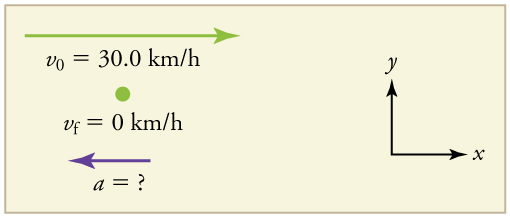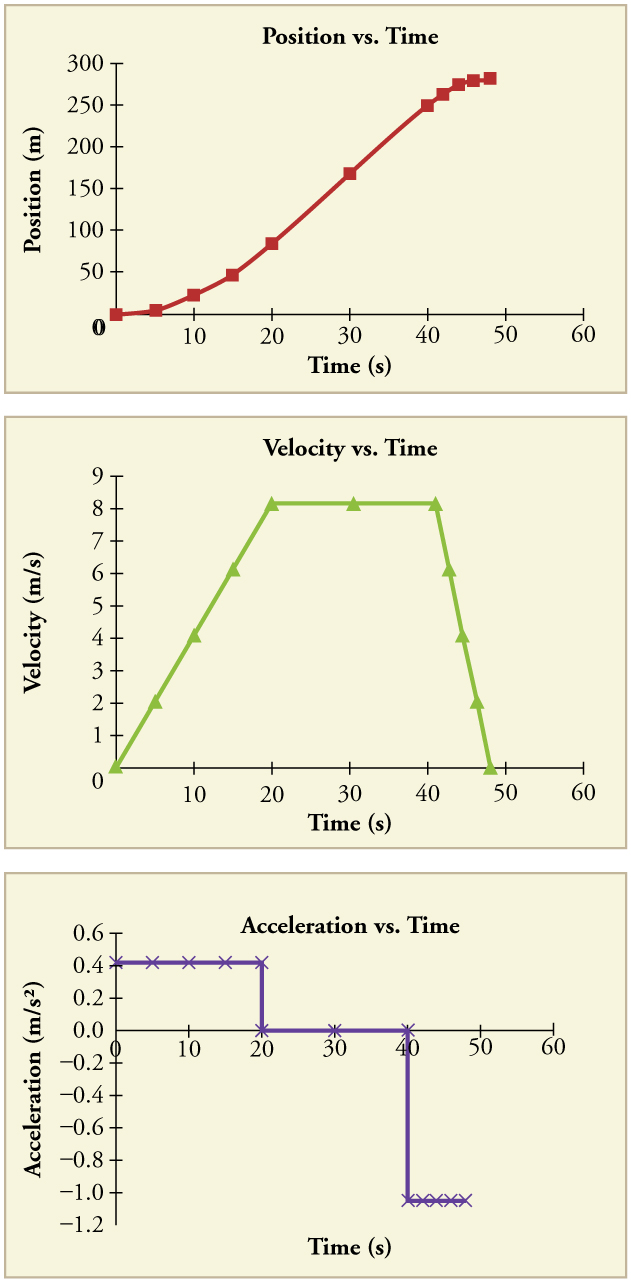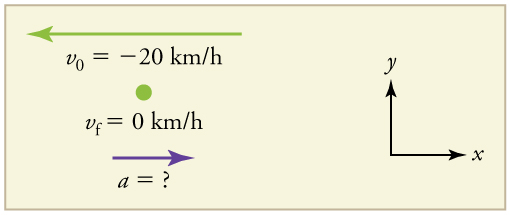| << Chapter < Page | Chapter >> Page > |
Now suppose that at the end of its trip, the train in [link] (a) slows to a stop from a speed of 30.0 km/h in 8.00 s. What is its average acceleration while stopping?
Strategy

In this case, the train is decelerating and its acceleration is negative because it is toward the left. As in the previous example, we must find the change in velocity and the change in time and then solve for acceleration.
Solution
1. Identify the knowns. , (the train is stopped, so its velocity is 0), and .
2. Solve for the change in velocity, .
3. Plug in the knowns, and , and solve for .
4. Convert the units to meters and seconds.
Discussion
The minus sign indicates that acceleration is to the left. This sign is reasonable because the train initially has a positive velocity in this problem, and a negative acceleration would oppose the motion. Again, acceleration is in the same direction as the change in velocity, which is negative here. This acceleration can be called a deceleration because it has a direction opposite to the velocity.
The graphs of position, velocity, and acceleration vs. time for the trains in [link] and [link] are displayed in [link] . (We have taken the velocity to remain constant from 20 to 40 s, after which the train decelerates.)

What is the average velocity of the train in part b of [link] , and shown again below, if it takes 5.00 min to make its trip?

Strategy
Average velocity is displacement divided by time. It will be negative here, since the train moves to the left and has a negative displacement.
Solution
1. Identify the knowns. , , .
2. Determine displacement, . We found to be in [link] .
3. Solve for average velocity.
4. Convert units.
Discussion
The negative velocity indicates motion to the left.
Finally, suppose the train in [link] slows to a stop from a velocity of 20.0 km/h in 10.0 s. What is its average acceleration?
Strategy
Once again, let’s draw a sketch:

As before, we must find the change in velocity and the change in time to calculate average acceleration.
Solution
1. Identify the knowns. , , .
2. Calculate . The change in velocity here is actually positive, since
3. Solve for .
4. Convert units.
Discussion
The plus sign means that acceleration is to the right. This is reasonable because the train initially has a negative velocity (to the left) in this problem and a positive acceleration opposes the motion (and so it is to the right). Again, acceleration is in the same direction as the change in velocity, which is positive here. As in [link] , this acceleration can be called a deceleration since it is in the direction opposite to the velocity.
Perhaps the most important thing to note about these examples is the signs of the answers. In our chosen coordinate system, plus means the quantity is to the right and minus means it is to the left. This is easy to imagine for displacement and velocity. But it is a little less obvious for acceleration. Most people interpret negative acceleration as the slowing of an object. This was not the case in [link] , where a positive acceleration slowed a negative velocity. The crucial distinction was that the acceleration was in the opposite direction from the velocity. In fact, a negative acceleration will increase a negative velocity. For example, the train moving to the left in [link] is sped up by an acceleration to the left. In that case, both and are negative. The plus and minus signs give the directions of the accelerations. If acceleration has the same sign as the velocity, the object is speeding up. If acceleration has the opposite sign as the velocity, the object is slowing down.
An airplane lands on a runway traveling east. Describe its acceleration.
If we take east to be positive, then the airplane has negative acceleration, as it is accelerating toward the west. It is also decelerating: its acceleration is opposite in direction to its velocity.
Learn about position, velocity, and acceleration graphs. Move the little man back and forth with the mouse and plot his motion. Set the position, velocity, or acceleration and let the simulation move the man for you.

Is it possible for speed to be constant while acceleration is not zero? Give an example of such a situation.
Is it possible for velocity to be constant while acceleration is not zero? Explain.
Give an example in which velocity is zero yet acceleration is not.
If a subway train is moving to the left (has a negative velocity) and then comes to a stop, what is the direction of its acceleration? Is the acceleration positive or negative?
Plus and minus signs are used in one-dimensional motion to indicate direction. What is the sign of an acceleration that reduces the magnitude of a negative velocity? Of a positive velocity?
A cheetah can accelerate from rest to a speed of 30.0 m/s in 7.00 s. What is its acceleration?
Professional Application
Dr. John Paul Stapp was U.S. Air Force officer who studied the effects of extreme deceleration on the human body. On December 10, 1954, Stapp rode a rocket sled, accelerating from rest to a top speed of 282 m/s (1015 km/h) in 5.00 s, and was brought jarringly back to rest in only 1.40 s! Calculate his (a) acceleration and (b) deceleration. Express each in multiples of by taking its ratio to the acceleration of gravity.
A commuter backs her car out of her garage with an acceleration of . (a) How long does it take her to reach a speed of 2.00 m/s? (b) If she then brakes to a stop in 0.800 s, what is her deceleration?
(a)
(b)
Assume that an intercontinental ballistic missile goes from rest to a suborbital speed of 6.50 km/s in 60.0 s (the actual speed and time are classified). What is its average acceleration in and in multiples of

Notification Switch
Would you like to follow the 'College physics' conversation and receive update notifications?